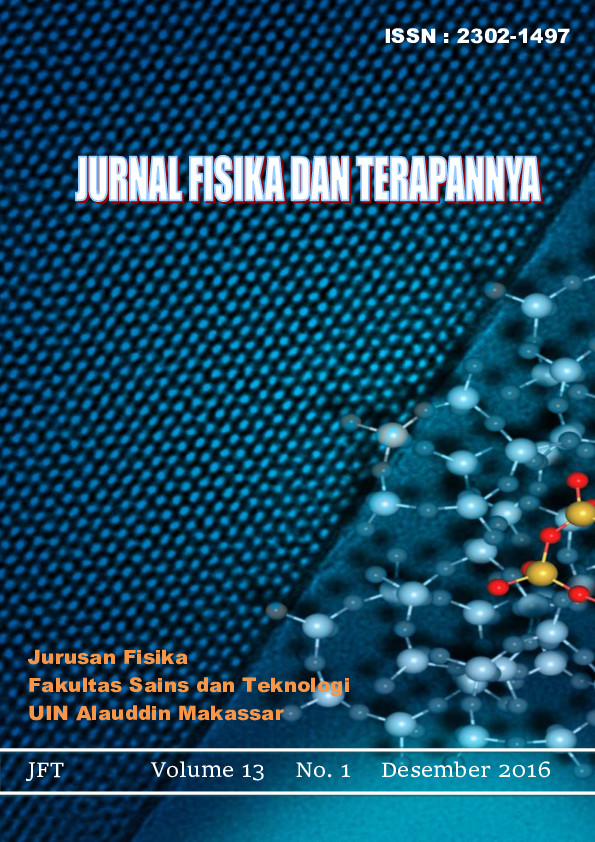EFEKTIVITAS ADSORPSI KULIT MANGGA, KULIT PEPAYA DAN BATANG PISANG SEBAGAI PENYERAP TIMBAL (Pb) PADA AIR LINDI TPA TAMANGAPA
Abstract
One threat today is the destruction of the environment waste pollution. Waste of mango peel, papaya peel and banana stem bark can be used to absorb heavy metals in a body of water such as waste containing cellulose and pectin. Leachate is the result of a pile of garbage that have decomposed physical, chemical and biological decay results contain harmful substances such as heavy metals. In this study attempted an adsorption method using waste mango peel, papaya peel and banana stem as an adsorbent to absorb heavy metals in leachate is adsorbat. With adsorption process mango peel, papaya peel and banana stem as adsorbent divided into several mass size is 1, 1.5 and 2 grams with a variety of contact time of 40, 60 and 80 minutes as the independent variables in the study and the stirring speed as a fixed variable. Leachate used contain heavy metals Pb of 1.58 mg/l. After analysis using the SSA found that the highest effectiveness in the mango peel adsorb Pb, namely the addition of mango peel masses as much as 1 gram to 40 minutes of contact time with the absorption efficiency of 93.67%; the highest effectiveness in papaya peel adsorption of Pb, namely the addition of papaya mass of 1.5 grams with a contact time of 40 minutes with the absorption efficiency of 65.82%; the highest effectiveness in the banana stem adsorption of Pb, namely the addition of banana stem mass 1 gram with a contact time of 40 minutes with the absorption efficiency of 56.33%.Downloads
References
Ajila, C.M., Bhat, S.G. & Prasada Rao, U.J.S, 2007, Valuable components of raw and ripe peels from two Indian mango varieties. Food Chem.102: 1006-1011.
Irawan, Candra dkk, 2012, Pengaruh Massa Adsorben, Lama Kontak Dan Aktivasi Adsorben Menggunakan HCl Terhadap Efektivitas Penurunan Logam Berat (Fe) Dengan Menggunakan Abu Layang Sebagai Adsorben, Jurnal, Balikpapan: Politeknik Negeri Balikpapan.
Kristiyani, Dyah dkk, 2012, Pemanfaatan Zeolit Abu Sekam Padi Untuk Menurunkan Kadar Ion Pb2+ Pada Air Sumur, Jurnal, Semarang: Universitas Negeri Semarang.
Maisovia, Siti, 2014, Tingkat Pencemaran Logam Berat (Pb, Cu, Cd) dalam Air Lindi di Tempat Pembuangan Akhir Sampah Kota Probolinggo dan Pengaruhnya Terhadap Kualitas Air Permukaan (Sumur), Skripsi, Jember: Universitas Jember.
Muna, Ai, Nailil, 2011, Kinetika Adsorpsi Karbon Aktif dari Batang Pisang Sebagai Batang Adsorben Untuk Penyerapan Ion Logam Cr(VI) Pada Air Limbah Industri, Skripsi, Semarang: Universitas Negeri Semarang.
Nor, Fahrizal dkk, 2014, Sintesis Biomassa Bulu Ayam Teraktivasi NaOH2SO3 Aplikasinya Penurun Kadar Tembaga Limbah Elektrolating, Skripsi, Semarang: Universitas Negeri Semarang.
Rohani, Dian, Anita, dkk, 2011, Pengukuran Efektivitas Kulit Singkong, Kulit Ubi Jalar, Kulit Pisang dan Kulit Jeruk Sebagai Bahan Penyerap Besi (Fe) dan Mangan (Mn) Pada Air Lindi TPA, Jurnal, Malang: Universitas Brawijaya.
Sofiana, Heni, dkk, 2012, Pengambilan Pektin dari Kulit Pepaya Dengan Cara Ekstraksi, Jurnal, Semarang: Universitas Diponegoro.


